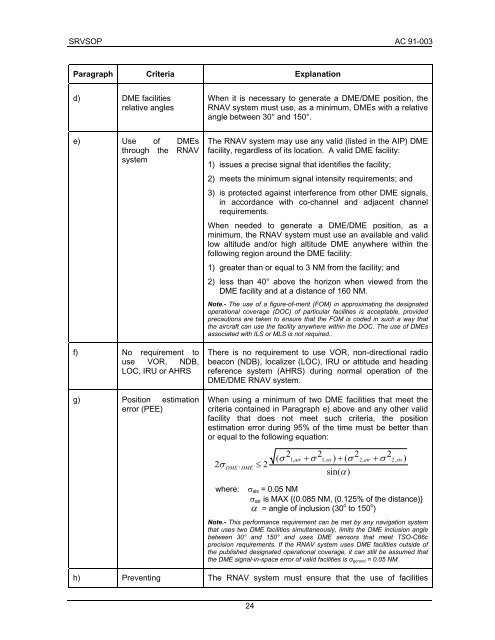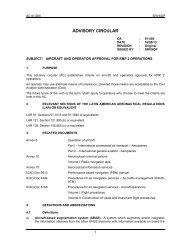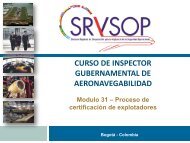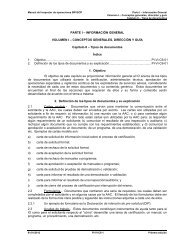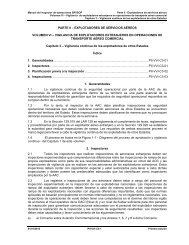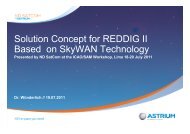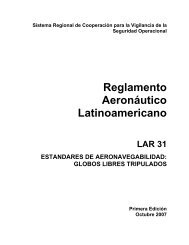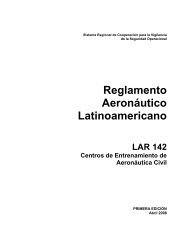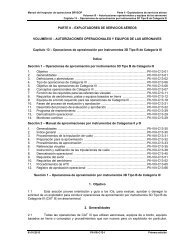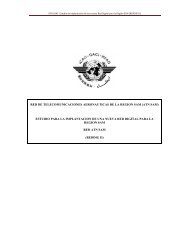ac 91-003 srvsop - ICAO
ac 91-003 srvsop - ICAO
ac 91-003 srvsop - ICAO
You also want an ePaper? Increase the reach of your titles
YUMPU automatically turns print PDFs into web optimized ePapers that Google loves.
SRVSOP AC <strong>91</strong>-<strong>003</strong><br />
Paragraph Criteria Explanation<br />
d) DME f<strong>ac</strong>ilities<br />
relative angles<br />
e) Use of DMEs<br />
through the RNAV<br />
system<br />
f) No requirement to<br />
use VOR, NDB,<br />
LOC, IRU or AHRS<br />
g) Position estimation<br />
error (PEE)<br />
When it is necessary to generate a DME/DME position, the<br />
RNAV system must use, as a minimum, DMEs with a relative<br />
angle between 30° and 150°.<br />
The RNAV system may use any valid (listed in the AIP) DME<br />
f<strong>ac</strong>ility, regardless of its location. A valid DME f<strong>ac</strong>ility:<br />
1) issues a precise signal that identifies the f<strong>ac</strong>ility;<br />
2) meets the minimum signal intensity requirements; and<br />
3) is protected against interference from other DME signals,<br />
in <strong>ac</strong>cordance with co-channel and adj<strong>ac</strong>ent channel<br />
requirements.<br />
When needed to generate a DME/DME position, as a<br />
minimum, the RNAV system must use an available and valid<br />
low altitude and/or high altitude DME anywhere within the<br />
following region around the DME f<strong>ac</strong>ility:<br />
1) greater than or equal to 3 NM from the f<strong>ac</strong>ility; and<br />
2) less than 40° above the horizon when viewed from the<br />
DME f<strong>ac</strong>ility and at a distance of 160 NM.<br />
Note.- The use of a figure-of-merit (FOM) in approximating the designated<br />
operational coverage (DOC) of particular f<strong>ac</strong>ilities is <strong>ac</strong>ceptable, provided<br />
precautions are taken to ensure that the FOM is coded in such a way that<br />
the aircraft can use the f<strong>ac</strong>ility anywhere within the DOC. The use of DMEs<br />
associated with ILS or MLS is not required..<br />
There is no requirement to use VOR, non-directional radio<br />
be<strong>ac</strong>on (NDB), localizer (LOC), IRU or attitude and heading<br />
reference system (AHRS) during normal operation of the<br />
DME/DME RNAV system.<br />
When using a minimum of two DME f<strong>ac</strong>ilities that meet the<br />
criteria contained in Paragraph e) above and any other valid<br />
f<strong>ac</strong>ility that does not meet such criteria, the position<br />
estimation error during 95% of the time must be better than<br />
or equal to the following equation:<br />
2σ<br />
DME / DME<br />
24<br />
≤ 2<br />
( σ<br />
2<br />
1,<br />
air<br />
where: σsis = 0.05 NM<br />
+ σ<br />
2<br />
) (<br />
2<br />
1,<br />
sis + σ 2,<br />
sin( α)<br />
air<br />
+ σ<br />
2<br />
2,<br />
sis<br />
σair is MAX {(0.085 NM, (0.125% of the distance)}<br />
α = angle of inclusion (30 o to 150 o )<br />
Note.- This performance requirement can be met by any navigation system<br />
that uses two DME f<strong>ac</strong>ilities simultaneously, limits the DME inclusion angle<br />
between 30° and 150° and uses DME sensors that meet TSO-C66c<br />
precision requirements. If the RNAV system uses DME f<strong>ac</strong>ilities outside of<br />
the published designated operational coverage, it can still be assumed that<br />
the DME signal-in-sp<strong>ac</strong>e error of valid f<strong>ac</strong>ilities is σgorund = 0.05 NM.<br />
h) Preventing The RNAV system must ensure that the use of f<strong>ac</strong>ilities<br />
)


